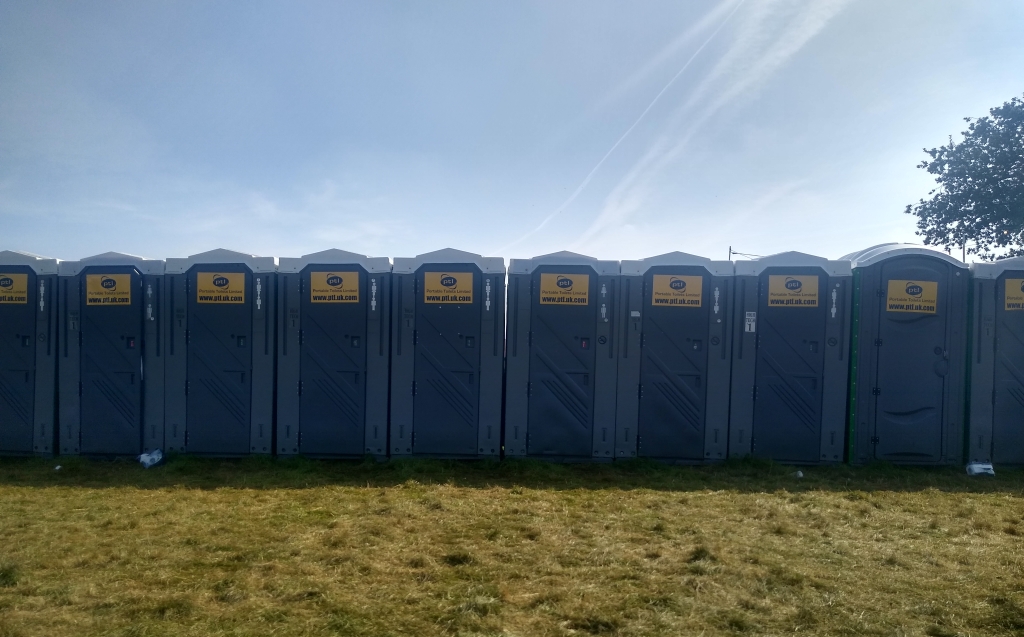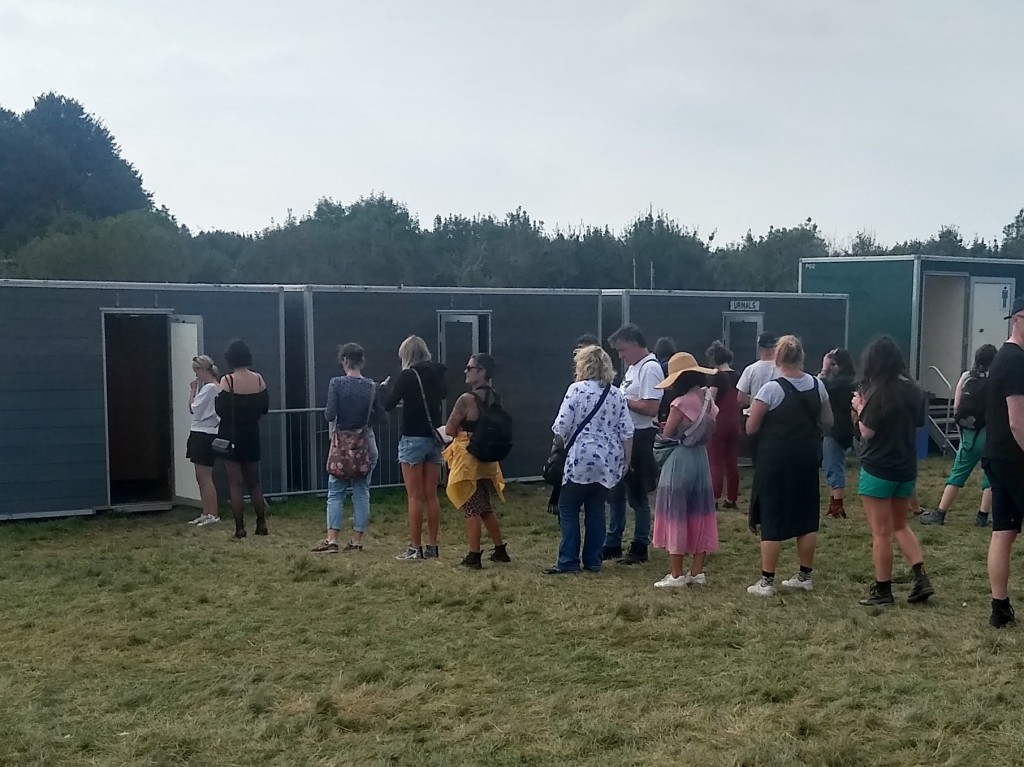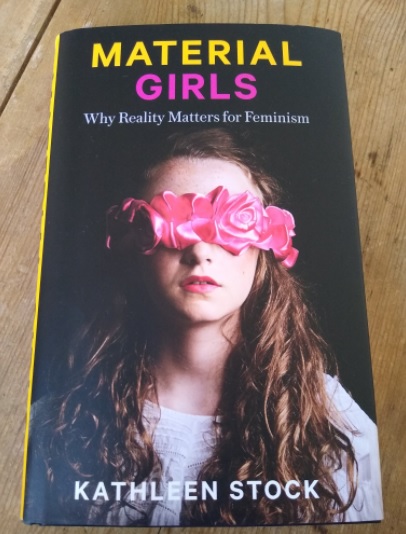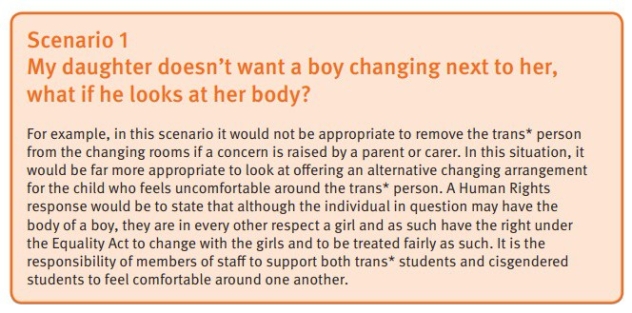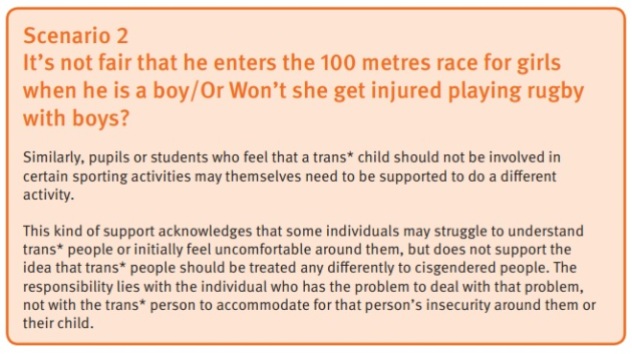
When there is conflict between trans rights and women’s rights (such as whether toilets and changing rooms should be segregated by ‘sex’ or ‘gender’) an open debate should be encouraged to ascertain how best to accommodate the rights of both parties. This hasn’t happened, and it hasn’t happened in a big way, so it’s worth looking at how and why the debate has been stifled.
The Gender Recognition Act 2004 gave trans people a right to be legally recognised as the opposite sex. The Equality Act 2010 gave the characteristic of ‘gender reassignment’ a protected category status. At that time ‘gender reassignment’ essentially meant ‘sex change’ – the language used in the Act refers to transsexuals, and people understood ‘trans’ to mean a transition of some sort, usually (at that time) from male to female. The Act was for a person who was ‘…proposing to undergo, is undergoing or has undergone a process (or part of a process) for the purpose of reassigning the person’s sex by changing physiological or other attributes of sex’. Although biologically impossible, sex change was recognised in law as it was the only treatment which could alleviate the suffering of a minority of people with gender dysphoria.
Things have changed greatly since 2004, and the pace of that change has accelerated since 2010. The use of the word ‘trans’ no longer necessarily indicates any kind of transition, the word ‘transgender’ has replaced ‘transsexual’ and ‘sex change’ has disappeared altogether in public discourse. An Act which was formulated to protect a tiny minority of people who experienced such discomfort with their biological sex they would risk invasive surgery to fix it, became an Act which protected a larger minority of people whose ‘identity’ fell under the ever-widening trans umbrella, whether or not there was a medical diagnosis or any kind of transition. The Act itself didn’t change but the definition of ‘trans’ did. Arguably the biggest change was the insistence that now a man who believed himself to be a woman was actually a woman, and had always been a woman.
The disadvantage of formulating a protected category with indistinct boundaries is that it can grow and grow until it hardly resembles the original definition at all. There should be public unease about protecting the ‘rights’ of a cross-dressing middle-aged man to get undressed in the same changing room as a teenage girl, but this aspect of the proposed changes to the GRA has been largely ignored. On the contrary, any mention of the potential risks will result in the accusation of inciting hatred against a marginalised community. The wider public perception of transgender as ‘sex change’ has remained back in the times when the original Act was drawn up to protect it, but the contents of the category itself have moved on.
The Act is therefore no longer fit for purpose, but not for the reasons that trans advocacy groups would have you believe. The view of activists is that the Act needs to be updated to take away any ‘gatekeeping’ of trans identities, such as doctor’s reports, surgery or treatment of any kind, or even a ‘binary’ understanding of sex in the first place. A person’s gender, it is said, should be entirely theirs to define, and so gender self-definition is being promoted as the only humane way for the Act to go. The problem with this is that without any gatekeeping at all, there is a much greater risk to women from predatory men misusing the new definition. This side of the argument has been almost entirely closed down, despite the fact that women are still supposedly a protected category based on sex, and therefore should have been allowed a voice in the debate.
The new meaning of trans is currently being cemented into public consciousness by some very simple ideas used in a rather emotionally manipulative way. These ideas have been promoted so widely as to have reached the status of ‘self-evident’:
- Trans people are ‘Born in the Wrong Body’
- Gender is innate
- Around half of trans people will attempt suicide
- Trans people suffer abuse more than any other group
- Only trans people can talk about trans issues
There is no evidence for any of this, and plenty of evidence against. ‘Born in the wrong body’ is a feeling or a belief so it cannot be proved or disproved: it relies solely on the say-so of the speaker and whether or not they are being honest. (Imagine if the same criteria were applied to people with disabilities applying for disability benefits!) Innate gender would rely on there being a male or female brain, an idea disproved repeatedly by modern neuroscience, or on there being a male or female ‘essence’ or ‘spirit’, which is akin to a religious belief: again, unprovable and unmeasurable. The suicide stats have been debunked in several different studies but are still used repeatedly as though they are fact, despite the risks outlined by the Samaritans of associating suicide ideation with one particular cause. The crime stats for the UK show that trans people are actually less likely to be the victims of homicide than the perpetrators. And on gender issues trans people are not the only experts: there is a huge body of work on the subject by feminists, partly because gender is one of the social structures used to keep women in their place and uphold the Patriarchy. Women have a stake in this.
Possibly because there is a lack of evidence to back up trans ideology, there has been a sustained campaign to rule feminists out of the debate, and it has been done partly by ensuring there is no debate to start with. The hashtag #NotaDebate is routinely used to protest against feminist meetings and to suggest that people who want to debate are actually trying to deny trans people’s right to exist. Just to want a debate at all is framed as transphobic.
In 2015 the Trans Inquiry, led by Maria Miller and the Women and Equalities Committee, invited contributions from trans groups and other interested parties to give evidence. There were 208 written submissions from groups and individuals, including trans advocacy groups and women’s groups. Of these a number were called as witnesses, to provide further evidence and answer questions from MPs. Fifteen of these were trans people or groups, a further handful were health professionals (mostly working in gender identity settings) and absolutely none of them were women’s groups. On the subject of prisons for example, this led to the anomaly whereby no mention was made of the nefarious reasons that a male prisoner may wish to begin transitioning in prison (listed by the British Association of Gender Identity Specialists in their written evidence), whereas a question about strip-searching prisoners precipitated a collective bout of amnesia from both expert witnesses, and was then not pursued by the questioner. A women’s group may have had something to say about the right of a female employee to refuse to strip search a male body, but no women’s groups were there to do so.
The Trans Inquiry legitimised the notion pushed by trans groups that only trans people should be allowed to speak on trans issues. Amongst the groups invited to give verbal evidence were Action for Trans Health, GIRES, Trans Media Watch, Gendered Intelligence, Mermaids and the Scottish Trans Alliance. Since then these same few groups have been allowed a near monopoly on trans discourse, consulted by everyone from the BBC to the NHS, the NSPCC, the EHRC, schools, prisons, the Girl Guides, universities, political parties and the media. Some of these organisations then recommend all the same groups for their members or customers to go to for ‘more information’. The same mantras are being repeated on an endless circular self-reinforcing loop because nobody has been allowed to challenge them. All of them, it goes without saying, are to the benefit of the trans community. No consideration is given to any other protected groups. Not women, not children.
The Trans Report, published that year, was therefore predictably one-sided. Not only had women’s groups been excluded, but Maria Miller herself made a little dig about ‘purported feminists’ in her dismissal of those expressing criticism. In spite of the government’s cautious response to the report, a Guide for Service Providers was published in November 2015, in association with Gendered Intelligence. It was written as if the recommendations of the report had already been implemented. Service providers were told that the definition of trans included ‘transsexual, transgender, a cross-dresser (transvestite), non-binary and anyone else who may not conform to traditional gender roles’. This had changed considerably from the original Act’s definition. Services such as shops and leisure centres were advised that they must ‘Assume everyone selects the facilities appropriate to their gender’. This amounts in practice to something very close to gender self-ID. No laws had been changed to achieve this, and no impact assessments had been undertaken. Essentially at this point the UK government had given away the word ‘Woman’ without asking us first.
{Last week it was announced that Topshop had made all its changing rooms gender neutral, to appease a male customer who identified as trans non-binary, after he had complained in a tweet that he had been refused access to the women’s changing room. Topshop is a fashion retailer whose customer base is largely teenage girls and young women. Service providers now seem to think we have a law which protects young adult males from the indignity of being refused access to a teenage girls’ changing room. Meanwhile the Saturday girl, probably on minimum wage, has responsibility not just for the number of garments taken in, but also for the policing of which men should be allowed access. I hope they put her wages up.}
It wasn’t just the government who was keen to push forward trans rights. In 2014 the LGB support group Stonewall decided to add transgender people to their remit. From then on all LGB groups became LGBT groups, a move which tapped into the public support for LGB people at a time when same-sex marriage was in the headlines. Trans organisations have always been keen to make it clear that transgender is not a sexuality, probably because they wish to distance themselves from the evidence of autogynephilia (a sexual paraphilia associated with cross-dressing men), the highlighting of which is unlikely to foster much public support (although, unlike the accepted myths like ‘born in the wrong body’ there are decades worth of research and evidence to back it up). Trans people have benefitted from being a part of a group intended for minority sexualities, with its existing support base and funding, and have gained a much wider platform from doing so. One of the benefits has been that now anyone criticising trans rights can be accused of ‘attacking LGBT people’, and this has been very successful as a means of silencing women who want to support lesbian, gay and bisexual people. Lesbians have borne the brunt of the new trans activism: a lesbian refusing to accept the idea of a male-bodied potential sex partner is increasingly seen as transphobic by LGBT allies, and lesbians are attacked rather than supported by the organisations meant to represent them.
In October this year a meeting was held at Garden Court Chambers in London entitled ‘Progress and Challenges in Advancing Equality for Trans People in the UK’. It was hosted by the Human Rights Lawyers Association and the speakers included Bex Stinson from Stonewall and Michelle Brewer from TELI (Trans Equality Legal Initiative). Bernard and Terry from GIRES were in the audience and were also asked to speak. It was to be expected that the talks would focus on trans rights but nevertheless the extreme level of female erasure was breathtaking. When discussing the experience of trans people in prison for example, much was made of the human rights of a male bodied trans person to be strip searched by a person who matched his ‘gender identity’. One of the lawyers there had represented such a prisoner and had won the case. The word ‘dignity’ was used a lot. Not one human rights lawyer there even considered the dignity of the female prison staff asked to perform such an intimate task as part of a day’s work. In a similar vein, two of the speakers talked about the trans suicide rate in prison and both of them mentioned the most recent case, ‘just this last week’, to hushed and respectful silence. The trans prisoner they referred to was a man called Martin Eatough who was serving a life sentence for violently raping a fifteen year old girl. He had begun his ‘transition’ in prison and was taking hormones but had not yet had any surgery. The sympathy shown to this rapist because he now came under the trans umbrella obscenely overlooked the rights of his victim.
No suicide in prison should be tolerated, whatever the offence or the sex of the perpetrator. However, due to the tireless work of Trans Media Watch, it is now increasingly the case that male crimes are being reported as female ones. So it seems from reading press reports that a man can be a woman when committing rape or murder, but that he becomes trans again if he commits suicide. It’s a double whammy for his victim: if a crime which she has experienced as male violence cannot be named (does she have to refer to him as ‘she’ for fear of committing a hate crime?) and then his suicide is elevated in the press due to his trans status (most other prison suicides are not reported individually) then where does that leave the rights of the victim to be treated with dignity, respect or sympathy?
An evening spent with human rights lawyers highlighted how large a disparity there is between trans support groups and women’s support groups. The tactics of trans rights groups and allies to smear, no-platform and threaten people who do not support the dogma 100% has put women’s groups in an impossible position. Groups which cater for women, and are technically able to remain women-only under the current legislation, have in practice become overwhelmingly trans-inclusive. The mantra ‘transwomen are women’ is repeated ad nauseum to close down any argument, and women’s groups risk losing not only friends, but also jobs, and in some cases funding, if they voice any uncertainty. The trouble threatened by trans rights activists is often more than a small women’s centre can deal with.
High profile cases of no-platforming or public reprimand, such as Julie Bindel, Germaine Greer, Dame Jenni Murray, Chimamanda Ngozi Adichie and Linda Bellos have shown us that anyone can be a target of trans hate. They serve as a warning to us all. Best not to speak up.
On social media there is a constant stream of abuse from trans advocates and allies towards women who don’t believe everything they are told, as documented by the website terfisaslur. Some trans Twitter users seem to be making a career out of reporting feminists to their employers for stepping out of line. This has real life consequences such as the recent case of Anne Ruzylo, Labour party women’s officer in Bexhill and Battle. Accounts which challenge the trans narrative, such as transcrimeuk, are routinely shut down after mass reporting. The website was set up to collect data about trans crime because no public body is monitoring it. Trans lobbyists would prefer that you didn’t know these stats which contradict their own statements, and the press and prison service are colluding with this spreading of misinformation by recording crimes by gender identity instead of sex. This does not stop the majority of sexual crime being committed by males and the majority of victims being female, it just means we can’t talk about it. Claims by trans groups that there is no risk to women from male-bodied trans people are disproved by the number of male sex offenders in the UK currently identifying as women – EITHER ‘transwomen’ have male rates of violent criminal offending OR males will pretend to be women when it suits them. One of these has to be true. Women have a right to be worried.
The highly-respected academic Heather Brunskell-Evans was recently made the subject of a disciplinary investigation by the Women’s Equality Party over her comments on the BBC Radio 4 programme The Moral Maze. She had expressed her view that caution was needed when diagnosing children as transgender. This resulted in complaints from trans members of the party, and the party was ‘quick to act’ in raising a complaint with the Executive Committee. The opposite view meanwhile, that ‘trans kids’ should be affirmed and celebrated in their chosen identity, is being taught in primary schools by groups such as GIRES and Mermaids, despite there being no long term evidential base for diagnosing a child as transgender. Feminists have not yet succeeded in even getting consent education added to PHSE lessons in schools, but a trans dogma that can lead to a lifetime of medicalisation and sterility is being added with no public consultation and little parental awareness.
The Labour Party supports the updating of the GRA to include gender self ID and has recently appointed a nineteen year old man who identifies as a woman as its Women’s Officer in Rochester. The Green Party refers to women as ‘non-men’ in order to include trans and non-binary people in the category, although the category ‘man’ remains unaffected. The Conservative Party is planning to push through gender self-identity after a consultation on changes to the GRA in the new year. Trans activists at the Anarchist Bookfair attacked women handing out feminist leaflets about the impacts of the GRA. It seems there is no longer a political home for women.
Along with the slurs and public shaming meted out to women who don’t agree with the new gender identity rules, there has been a refusal to debate the issues publicly by trans activists themselves. Meetings of women wishing to discuss the proposed changes to the Gender Recognition Act have been disrupted, even though speakers have been invited from the trans community (and subsequently failed to attend). A refusal to debate by trans spokespeople like Paris Lees has led to the cancellation of slots on BBC Newsnight, and, even more worryingly, a consultation by the NSPCC was cancelled after representatives from the trans community refused to debate with Sarah Ditum, calling her a ‘notorious transphobe’. (Top tip: call a woman a transphobe often enough and you can then justify calling her a notorious transphobe). Ruth Hunt, CEO of Stonewall, refused to answer questions put to her by Times journalist Janice Turner, for an article she was writing about trans children. Feminists have always wanted this debate to be balanced and transparent and public. It’s beginning to look as though trans activists have something to hide.
The outcome of the tactic of #NotaDebate is that when there is a conflict of interests which needs to be talked about there is little public understanding of the issues. Facts are hidden and simple mantras take their place. Trans people can call on the support of not only trans groups but also LGBT groups, human rights organisations, political parties and even women’s groups. Women have effectively been left with nothing. Not only that but the protected category of sex, intended to protect women from discrimination, has been neutered by the inclusion of men. Groups and political parties set up to support women and level the playing field now have to be ‘inclusive’ in order to survive, despite the fact that the sex category ‘women’ is by definition ‘exclusive’. Prizes, awards, sports and jobs reserved for women are being awarded to men in the name of inclusivity. This is the natural consequence of giving away the word ‘woman’. We could still exclude trans-identified males from spaces reserved for women, if only we could name them as trans-identified males. Feminists are now increasingly adopting this choice of language in order to reclaim ‘Woman’ as a sex-specific category that belongs to us. We have to be able to assert our own boundaries.
The argument we have to contend with from trans activists and allies, is that transwomen are women, and not only that, but they are the most oppressed and marginalised of all women so they deserve more support than the rest of us. The fact of male anatomy, biology and physiology evidently doesn’t change this and nor does the fact of male socialisation. The argument usually made is that ‘transwomen’ do not benefit from male privilege as they have never felt ‘male’, but aside from the fact that privilege does not work in that way, it is irrelevant anyway: what men benefit from is female socialisation. When women are brought up under the constructs of gender they are socialised into wanting to please, to be nice, to be kind, to care about other people. Stepping out of line is painful, and also it is punished. Women who speak out about gender are called TERFs and TERFs are the same as Nazis and Nazis deserve violence. At least, that’s the view peddled by Action for Trans Health (remember? The group invited to give evidence at the Trans Inquiry?)
When trans activists say trans lives are #NotaDebate what they really mean is that they refuse to discuss women’s rights and they refuse to discuss child protection issues. The focus on listening to trans people has proved to be indulgent and infantalising towards the people it is meant to help, and it has led to an extreme level of entitlement amongst activists, evidenced by the level of verbal and physical violence deployed.
It’s sometimes difficult to remember, amongst all the arguments, exactly what women stand to lose here. The sex category ‘female’ is being asked to absorb the sex category ‘male’. What women are being forced to accept could literally not be any more extreme.
So, that’s the point we’re at. Changes to the Gender Recognition Act are due for consultation in Spring 2018. Grassroots groups of women are springing up everywhere as more and more women realise what’s happening. On Facebook, on Twitter and on Mumsnet, increasing numbers of women are finding groups where they are allowed to debate, and real-life groups are forming off the back of these. Unfunded and voluntary for the main part, ordinary but extraordinary women are working together to protect the rights of all women. Our voice is finally being heard in the mainstream media. There will be a tipping point where the number of women refusing to be silenced will overtake the number of women too scared to speak up.
If you want to find out more, or join in, go and look at Fair Play for Women, Transgender Trend, A Woman’s Place, Mayday for Women, Youth Trans Critical Professionals, the Lesbian Rights Alliance, Socialist Feminist Network and more. Come and join us. Remember, as a clever feminist recently coined it, what TERF really stands for is Telling Everyone Real Facts. And someone’s got to do it.


